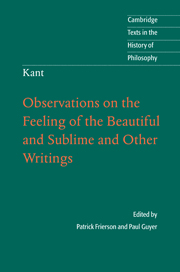Book contents
- Frontmatter
- Contents
- Introduction
- Chronology
- Further reading
- Note on the texts
- “Thoughts on the Occasion of Mr. Johann Friedrich von Funk's Untimely Death” (1760)
- Observations on the Feeling of the Beautiful and Sublime (1764)
- Remarks in the Observations on the Feeling of the Beautiful and Sublime (1764–65)
- “Essay on the Maladies of the Head” (1764)
- Inquiry Concerning the Distinctness of the Principles of Natural Theology and Morality (1764)
- M. Immanuel Kant's Announcement of the Program of his Lectures for the Winter Semester, 1765–1766 (1765)
- Herder's Notes from Kant's Lectures on Ethics (1762–64)
- Selected notes and fragments from the 1760s
- Index
- Cambridge texts in the history of philosophy
Observations on the Feeling of the Beautiful and Sublime (1764)
Published online by Cambridge University Press: 05 June 2012
- Frontmatter
- Contents
- Introduction
- Chronology
- Further reading
- Note on the texts
- “Thoughts on the Occasion of Mr. Johann Friedrich von Funk's Untimely Death” (1760)
- Observations on the Feeling of the Beautiful and Sublime (1764)
- Remarks in the Observations on the Feeling of the Beautiful and Sublime (1764–65)
- “Essay on the Maladies of the Head” (1764)
- Inquiry Concerning the Distinctness of the Principles of Natural Theology and Morality (1764)
- M. Immanuel Kant's Announcement of the Program of his Lectures for the Winter Semester, 1765–1766 (1765)
- Herder's Notes from Kant's Lectures on Ethics (1762–64)
- Selected notes and fragments from the 1760s
- Index
- Cambridge texts in the history of philosophy
Summary
First Section
On the distinct objects of the feeling for the sublime and the beautiful
The different sentiments of gratification or vexation rest not so much on the constitution of the external things that arouse them as on the feeling, intrinsic to every person, of being touched by them with pleasure or displeasure. Hence arise the joys for some people in what is disgusting to others, the passion of a lover that is often a mystery to everyone else, or even the lively repugnance that one person feels in that which is completely indifferent to another. The field for observations of these peculiarities of human nature is very extensive and still conceals a rich lode for discoveries that are as charming as they are instructive. For now I will cast my glance only on several places that seem especially to stand out in this region, and even on these more with the eye of an observer than of the philosopher.
Since a human being finds himself happy only insofar as he satisfies an inclination, the feeling that makes him capable of enjoying a great gratification without requiring exceptional talents is certainly no small matter. Stout persons, whose most inspired author is their cook, and whose works of fine taste are to be found in their cellar, get just as lively a joy from vulgarities and a crude joke as that of which persons of nobler sentiment are so proud.
- Type
- Chapter
- Information
- Publisher: Cambridge University PressPrint publication year: 2011
- 1
- Cited by



